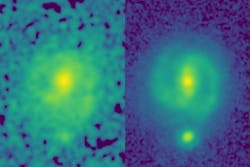Webb’s infrared images reveal surprising Milky Way-ish galaxies in early Universe
On December 25, 2021, after two decades of planning, NASA launched the James Webb Space Telescope (JWST), the most powerful space telescope ever built. Astrophysicists, astronomers, and scientists around the world knew JWST would provide the deepest eyes on the Universe and aid the quest to understand our origins—but even they are surprised by what Webb’s stunning infrared images are starting to reveal.
“When the first JWST data started to arrive in the summer of 2022, I was blown away by the sheer power and beauty of the high-resolution infrared images,” says Shardha Jogee, a professor of astronomy at The University of Texas at Austin. “And I was stunned to see that these images were revealing galaxies with stellar bars at early cosmic epochs, when the young Universe was a mere 20% of its present age!”
These stellar bars, almost invisible in previous Hubble Space Telescope images, were “popping out clearly in the JWST infrared images,” Jogee says. The finding of barred galaxies like the Milky Way in the young Universe has many far-reaching implications, so she immediately put her other projects on the back burner and focused on this JWST research instead.
Prior to JWST, images from Hubble hadn’t detected bars at such young epochs. In a Hubble image, one galaxy, EGS-23205, appears as a disk-shaped smudge, but in the corresponding JWST image shot this past summer, it’s a beautiful spiral galaxy with a clear stellar bar (see Fig. 1 and video above).
The team identified another barred galaxy, EGS-24268, also from about 11 billion years ago, which makes two barred galaxies existing farther back in time than any previously discovered (see Fig. 2). And they also found examples of four other barred galaxies from more than 8 billion years ago.The discovery of these barred galaxies, similar to our Milky Way, this early in the Universe will force astrophysicists to refine their theories of galaxy evolution.
JWST image quality
JWST differs from Hubble in several key ways: it has a larger mirror (6.5 m), orbits much farther away (approximately 1 million miles from Earth around a special point called the Sun-Earth L2 point), operates at a much lower temperature, has infrared instruments, and can see through dust.
“As a result, JWST can deliver images that are more sensitive, sharper, and at longer infrared wavelengths than Hubble,” says Jogee. “These JWST infrared images can powerfully unveil structures such as stellar bars in distant galaxies and trace their underlying stellar mass.”
Discovery of stellar bars in a young Universe
Stellar bars play an important role in the galaxy evolution for several reasons.
“First, stellar bars solve the supply chain problem in galaxies by transporting gas from outer parts of the galaxy into the central regions where the gas is rapidly converted into new stars,” explains Jogee. “This high star formation rate in the central regions can be tens to hundreds of times larger than the rest of the galaxy!”
Second, stellar bars also partially help to grow central supermassive black holes in galaxies by driving gas part of the way it needs to go on its journey toward the black hole.
And stellar bars can effectively stress test and help improve galaxy evolution models. “For the theoretical model to produce a bar, it must correctly model the gas, stars, and dark matter in the galaxy, and how these three components interact with each other,” she adds.
A Universe full of beauty and surprises
“It always amazes me that we live in a beautiful Universe that’s full of surprises and never ceases to challenge us,” says Jogee. “Just when we think we have things figured out, the new data say ‘Wait a minute, not so fast!’ In this case, the sheer power of the JWST infrared high-resolution images blew us away and led to the surprising finding of barred galaxies at early cosmic epochs when the Universe was a mere 20% of its present age.”
This research also exemplifies two remarkable things. “First, JWST data have the power to build the STEM pipeline in our nation by inspiring diverse young scientists to get involved in research,” Jogee points out. “Second, science transcends national and political differences.”
Jogee gives a shoutout to the wonderful collaboration between scientists at different career stages and all around the world, and in particular: UT Ph.D. student Kay Yuchen Guo, who led the quantitative analysis, and UT undergraduates Eden Wise and Micaela Bagley, who calibrated the images. Jogee and UT colleague Professor Steven Finkelstein provided research and technical expertise, while collaborators across the world in the Cosmic Evolution Early Release Science Survey (CEERS) team provided input.
Building inclusive STEM communities
Beyond this research project with JWST, Jogee’s research program broadly explores how galaxies and their constituent stars, black holes, and dark matter grow across cosmic time.“My group uses NASA’s space telescopes, McDonald Observatory and other ground telescopes, as well as the Texas Advanced Computing Center,” she says. “While conducting this research, I tremendously enjoy simultaneously training the next generation of young scientists to engage in STEM research and careers. I believe the journey of science exploration belongs to everyone and we get the best far-reaching results by having diverse teams.”
Jogee is passionately committed to advancing inclusive excellence and a broader participation of women and other groups traditionally under-represented in STEM. “I also believe it’s essential for scientists and research universities to tell the public at large what we do, how we do it, and why,” she says.
FURTHER READING
Y. Guo et al., arXiv:2210.08658v2 [astro-ph.GA] (Dec. 12, 2022); https://arxiv.org/abs/2210.08658.
About the Author
Sally Cole Johnson
Editor in Chief
Sally Cole Johnson, Laser Focus World’s editor in chief, is a science and technology journalist who specializes in physics and semiconductors.


